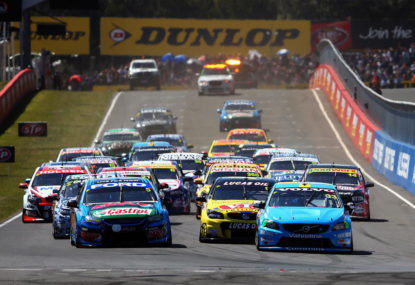'Welcome back': Reliving the last Chinese Grand Prix ahead of its much-anticipated return five years later
Five-years is a long time in motorsport, let alone the general state of the world – especially given the impact of the Covid-19 pandemic…

Evolution is a fundamental part of motorsport. As further advances in technology are made, the boundaries continue to shift and adapt to the current automotive climate.
Formula One in 2014 made a leap into hybrid technology, killing off the scream of its previous V8 engine for a smaller, more efficient and more powerful V6-turbo.
Endurance prototypes contesting the prestigious 24 Hours of Le Mans have been utilising various solutions to hybrid power for many years now.
The mighty V8 Supercar has been a stalwart of Australian motorsport, since the inception of the V8 category in 1997. The eight-cylinder engines have become icons, with the bellowing roar becoming synonymous to the blue-collared nature of Australian touring cars.
The humble Holden Commodore and Ford Falcon saloon cars have evolved through many iterations, with the DNA perennially revolving around a four-door family car, powered by the ‘thunder from Down Under’, being the V8.
Though a point in time has been reached, where the revolution is on the horizon for the Aussie touring car landscape. This year has rather underwhelmingly welcomed in Gen2; the next phase of development for the Supercars, opening the door to new engine types and car shapes.
Gen2’s introduction has been underwhelming simply because nothing has changed this season with the architecture of the cars. The remaining three manufacturers in the sport have retained the previous ‘Car of The Future’ vehicles, with eyes on welcoming Gen2 enhancements from 2018.
The first ‘proper’ new chassis to debut in Supercars under Gen2 will be the French-made Opel Insignia, badged as the Holden Commodore. For 2018 at least, the all-new Commodore will retain the current V8 engine, though a 3.6 litre twin-turbo V6 is set to be tested through several wildcard Supercars races next year.
So while Supercars is slowly shifting towards the concept of smaller engines, there will be many who will state that the category is dead without the growl of the V8s. Many who cite fond memories of exhilaration from witnessing the colossal saloon cars dancing atop Mount Panorama and the like.
Supercars is about more than just the method of power output. It is known for its constant delivery of enthralling racing and rivalry between manufacturers in Holden and Ford – who, despite not having any local presence anymore, can still incite supporter tribalism.
2017 thus far has provided viewers with another classic brawl for the championship between the Holden and Ford camps, with powerhouse teams in Triple Eight and DJR Team Penske going blow for blow.
It would be remiss to not mention the drivers and the strong presence they have, particularly in raising the profile of the category. Craig Lowndes, Jamie Whincup, Mark Winterbottom, and even young-hands such as Scott McLaughlin and Chaz Mostert, are all pivotal in making Supercars great.
Close racing and a strong base of drivers and teams is what should be the fundamentals of what makes a category as good as it may be.
As disappointing as it is to lose stalwart parts of Supercars such as the V8 engine, along with the ceasing of local manufacturing of Holden and Ford road cars, it is worth relishing the next chapter of Supercars, if it’ll involve new marques and a Commodore versus Mustang rivalry.
Supercars in the end, will not be lost without the V8s. It is indeed with heavy hearts that this rambunctious chapter in the tale of Australian touring cars must conclude, though it would not be motorsport without evolution.